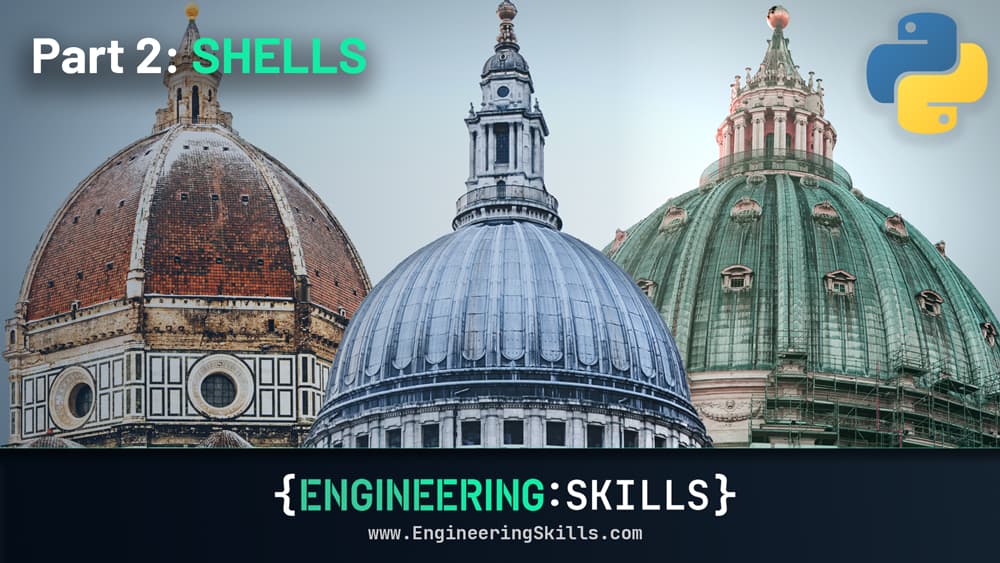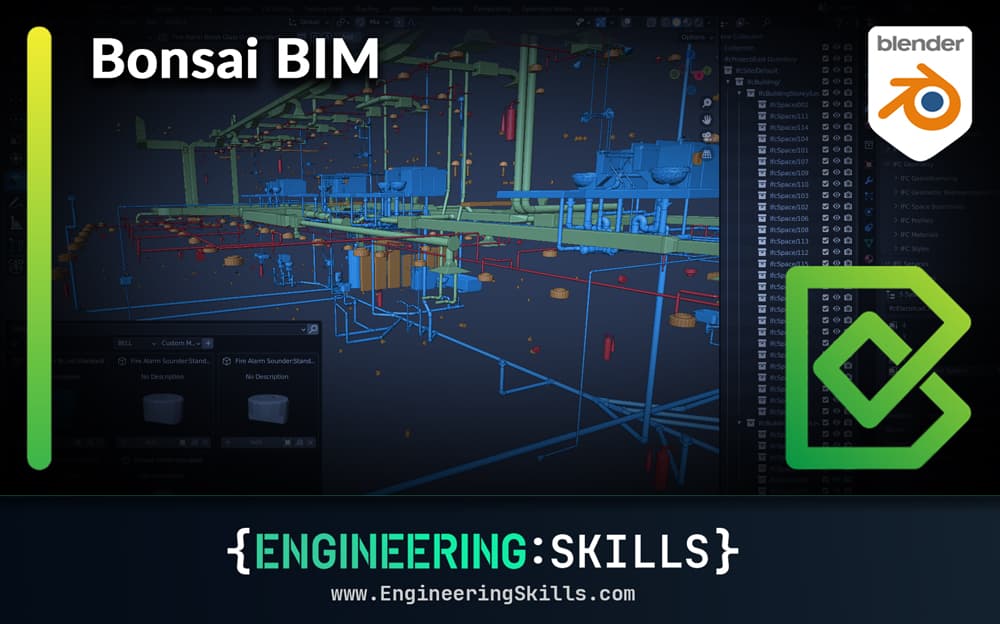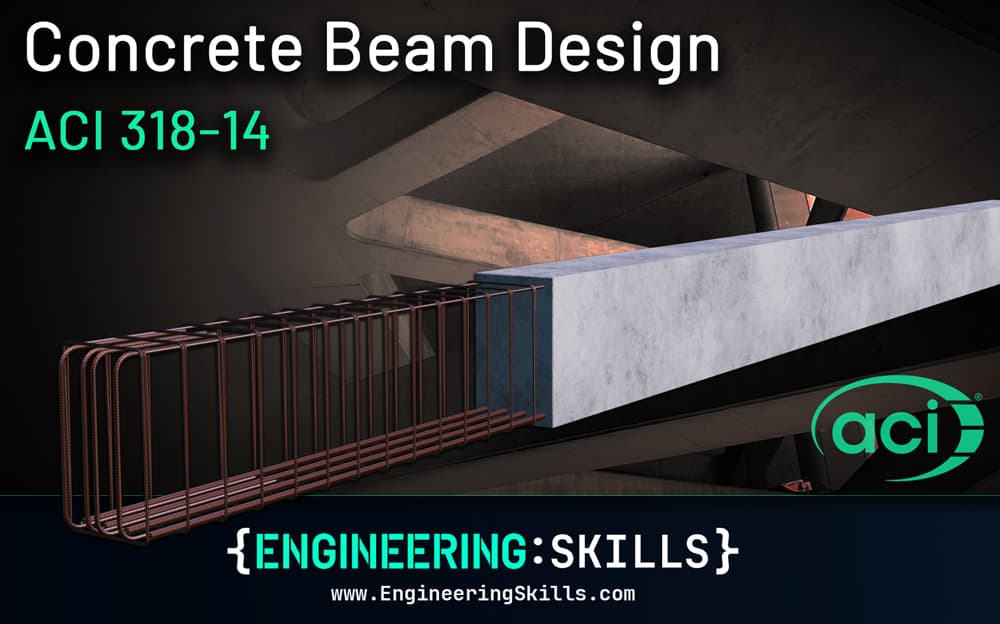DegreeTutors is now EngineeringSkills
![[object Object]](/_next/image?url=%2Fimages%2Fauthors%2Fsean_carroll.png&w=256&q=75)
Welcome to the new site, and the new name, EngineeringSkills.com!
This is the new version of DegreeTutors.com and combines that site, the DegreeTutors Podia site and Labs, all into one platform. I've fully custom-coded and developed this site to be the best place to learn engineering online!
In this article I'll...
- introduce you to the new site,
- explain why I've spent so much time building it,
- point out some of the new features and improvements I've made
- and give you a sense of what I have planned for the future.
But first, let me get some housekeeping out of the way...
All of the courses that you had access to on DegreeTutors.com are available for you here on EngineeringSkills.com. Simply create an account with the same email address you used previously, and you'll have access to all of your courses here as soon as you log in.
- So, if you purchased individual courses previously, you'll have access to those courses here.
- If you were an annual subscriber, your subscription will continue here and auto-renew as normal (you can continue to manage your (legacy) subscription from Podia - new subscriptions made through this site can be managed from this billing dashboard).
- If you were a lifetime subscriber, you'll have access to all of the courses here too, once you log into your new account.
Make sure to use the same email address you used previously so I can recognise you and grant you access to your courses.
If anything doesn't work as expected, please get in touch and I'll get it sorted for you ASAP - there may be some teething problems, but I'll get them sorted as quickly as possible.
The Podia site and Labs will remain live for the time-being, but I'll eventually close these down. I'll give you plenty of notice before I do that though. From now on, you should consider EngineeringSkills.com to be the new home for all of my courses and content.
Why the change?
So there are two big parts to this change, the new site and the new name - let's start with the new site.
A new modern tech stach to carry us for the next 10 years
The very first DegreeTutors course was published in June 2015! Fundamentals of Structural Analysis is nearly 10 years old - to say this is hard to believe is an understatement! Way back then, I published this first course on Udemy. I had no idea what DegreeTutors would grow into or that teaching engineering online would become a full-time endeavour.
I was just polishing up my teaching notes into a course and Udemy offered me a great way to share it with the masses. I didn’t even code back then (outside of Matlab) - so the thought of building my own platform couldn’t have been further from my mind.
Over the following couple of years, I released a handful more courses on Udemy. Before long though, I began to see the merits of moving away from Udemy and hosting my courses on a dedicated hosting platform. That’s where Podia comes into the story.
Podia has been a great solution - allowing me to build a course library with more control over how my courses are marketed. This was an important step in the journey - with this additional control, DegreeTutors started to become financially sustainable - which allowed me to dedicate more time to producing content and growing the audience.
However, while Podia has been a major improvement on the Udemy days, it has led to some awkwardness in the tech stack as DegreeTutors has grown and evolved. For example, we had...
- A main site for free tutorials and projects that was built on Wordpress
- Courses hosted on Podia
- Course notes and additional custom toolboxes on labs - a custom-coded site
- In later years, a discourse forum to manage student Q&A (I still really like this solution)
So, in early 2023, I set about building exactly the kind of platform I wanted, from the ground up…one suited to delivering technical engineering content. Conveniently, I had turned my hand to web development in the intervening years, so this was a challenge well within my wheelhouse.
The site you’re reading this on now is the end result. I’ll talk a little about the features later, but my hope is that from your perspective, the site just feels like a nicer place to consume content - and it should be a lot less confusing to navigate because we’ve gone from an ‘eco-system’ of sites to a single place to access everything.
This brings us to the new name...
A new (more suitable) name to take us where we're going
The name DegreeTutors reflects what I thought I was trying to do in the early days - at the time, I was a structural engineering lecturer, and my aim was to put a course online that would help (or tutor) students, just like the ones I was teaching every day on the civil engineering degree programme at the University of Nottingham. This is where the name DegreeTutors.com came from (plus I thought it was a pretty snappy domain name to get a hold of).
Like I said above, I didn’t ever think that this would grow the way it has and become what I do for a living! As DegreeTutors has grown, it’s become much clearer that the community has expanded way beyond undergraduate engineering students.
While many of you are indeed engineering students, many more are professional engineers, architects, building surveyors, contractors, researchers, educators and more. So, the name DegreeTutors doesn’t fully fit the bill, and hasn’t for some time.
In very many cases, I’m not tutoring people through an engineering degree - instead, I’m simply helping people build new engineering skills! After a long time pondering this, I finally decided to pull the trigger and hunt for a new, more appropriate name. As luck would have it, EngineeringSkills.com was available (although not for the usual $9.99 - I was late to the party and needed to pay quite a bit more 🙄).
So, with a sense of optimistic trepidation, we’re moving forward as EngineeringSkills.com. Changing a brand name, not to mention a domain name (say a prayer to the Google gods for me!), is quite a scary thing to do. So, fingers crossed, it’s the right move…but I guess only time will tell!
What's new?
Everything in one place
A lot has changed with the new site - from your perspective, probably the biggest change is that everything is now accessible in one location - there is no need to log into Podia (or Labs) to access course content. You can simply log into EngineeringSkills.com and access your course content there, alongside all of the free tutorials you previously read on DegreeTutors.com.
💡 Remember, you need to register an account on the EngineeringSkills website first and you need to use the same email address you used previously.
Better reading experience
The next big change you should notice is a general improvement in the reading experience. I’ve put a lot of time into making sure that the site can render technical content (code and equations) well.
We couldn’t do this on Podia, and frankly, it looked terrible on the DegreeTutors site. Equations and code looked a little better on Labs, but publishing on the backend took a phenomenal amount of time. Now, I can publish technical content much faster, and it appears much cleaner on the front end.
I’ve also implemented a dark mode for tutorial and course pages - this should make reading long-form content a little more comfortable, depending on your preference. The mode will default based on your system settings, but you can toggle dark/light mode on the pages it’s available for, by clicking the sun/moon button in the top menu bar.
Site-wide search (Cmd+K or Ctrl+K)
I’ve implemented a site-wide search that will search across all tutorials and course lessons. Currently, it will search by title, but I may make this more elaborate in the future. So, if you have a lesson in mind and you can recall even part of the title, you can search for it and jump straight to it.
🔎 You can access the search by clicking the magnifying glass in the top menu bar or with Cmd+K (on Mac) or Ctrl+K (on Windows).
Captions (subtitles) for all videos
I think I speak, or at least I try to speak, slowly and with a clear accent - but I know for many of you, I sound like I’m barely speaking English…and I’m doing it at 100 miles an hour! What can I say, I’m Irish!
Coverage of closed-captions or subtitles has been patchy in the past - but now I’m pleased to say that there is 100% caption coverage across all videos on EngineeringSkills.com. This will make it much easier to follow along if you find my presentation a little fast, particularly if English is not your first language. Note that you can also still slow the videos down (or speed them up) if you find that helpful.
The captions are auto-generated, so there may be the odd inaccuracy, but I generally find them pretty good. Auto-captioning has come a long way with the latest advances in AI…speaking of AI, this brings me to the next site upgrade!
New AI tools (in Beta)
Advances in neural network technology and the resulting large language models are in the process of transforming so much of how we interact with the world. This includes how we learn!
For someone like me, who publishes online educational content, I think this represents a massive opportunity - an opportunity to leverage this technology to provide a better, more immersive learning experience.
I’ve been experimenting with ways of using AI in the new site. To start with, I have implemented an AI chatbot or tutor that can be accessed from each lesson page.
So, as you’re working through a lesson, you can have a back-and-forth interaction with an AI model on the topic. This can be helpful if you want to try to clarify your understanding of something we’re working on in a given lecture. (This is only available to logged-in users who are enrolled in a course.)
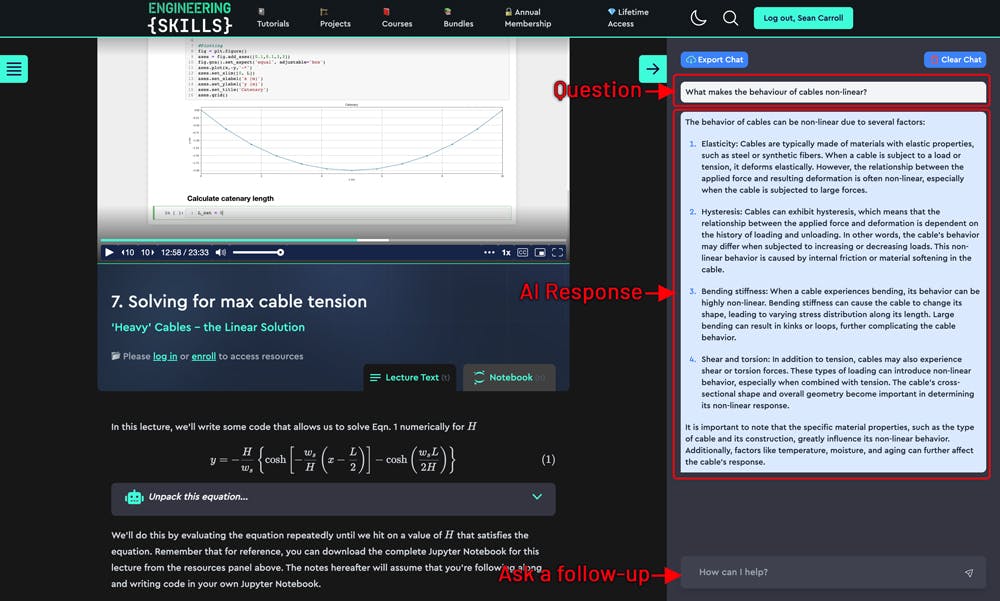
Typical lesson page with the AI chatbot deployed and ready to answer your questions.
🤖 To access the AI Tutor, simply click on the robot icon in the top right of any lesson page. The contents of your conversations are not saved or used in any further training or tuning activity. So keep in mind that when you refresh the page, the conversation history is gone.
Let me emphasise that at the time of writing, this should be considered a beta feature.
The model powering the chatbot is generic and hasn’t had any fine-tuning. You also need to be very careful relying on any language model for quantitative answers (it can very confidently give you the wrong answer) - so for now, use it with caution.
My plan is to further refine the model by providing additional training data on the structure and content of my courses so that at the very least, it can give sensible recommendations on where to find specific content.
In addition to the AI chatbot, for lectures that have accompanying text notes, I’m experimenting with in-line AI Explainer Boxes that can further explain particular equations or code blocks. Again, these are a work in progress at the minute - they’ll go through further iterations and refinement before being more widely implemented across the site.
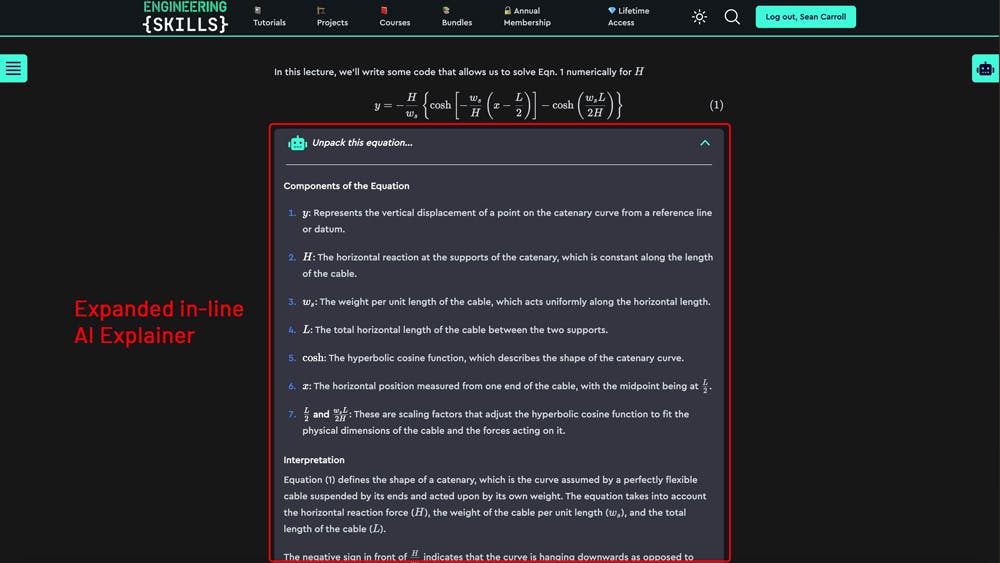
An in-line AI Explainer box that further explains the equation by defining it's elements and offering an interpretation.
As the AI industry and developer tooling continues to evolve, I’ll be on the lookout for how I can build in more features to further improve your user experience. I see this flexibility to build custom experiences as one of the major benefits of developing a completely custom platform.
Built-in Python coding on EngineeringSkills.com (in Beta)
You can now run Jupyter Notebooks directly on the EngineeringSkills website! This is something I’ve wanted to implement for a couple of years and it’s finally been implemented.
Take a look here and try it for yourself
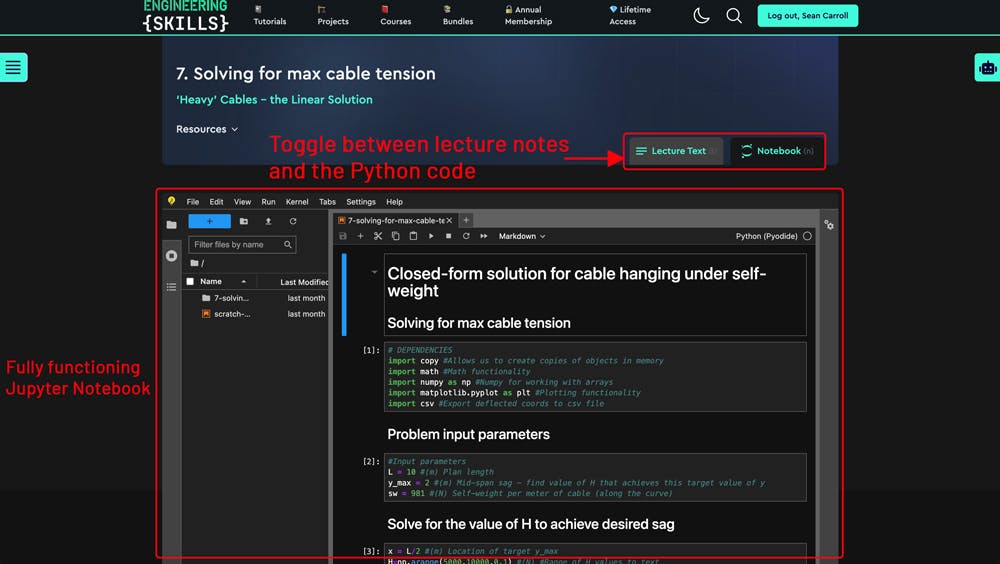
Toggle between the lesson notes and a fully functioning version of the Jupyter Notebook that accompanies the lecture.
For many of my courses, we use Python extensively and Jupyter Notebooks are my preferred way to write Python. So, the fact that we can now write and run code in the browser is quite exciting for me.
Much like the AI tools, this is still a beta feature - to be honest, I’m still working out the best way to use this feature; should I try to have a one-to-one mapping so that every lecture has the code we wrote in that lecture available in a notebook, or should I only provide the completed notebooks running in the browser from each section at the end of the section? As I say - I’m still figuring this out.
I can also imagine a case where the need to code alongside me while you take the course is more pronounced - along the lines of a Datacamp course. This would lead to a very different course-taking experience, so I’m still deliberating on this.
As I start to refine how I use this feature, I’ll keep you updated - also, please let me know if you have thoughts on how you’d like to see this feature used.
You’ll be able to tell which courses have online notebooks from the icon legend on each course listing page. If there’s a grey Python icon, it means the course has downloadable Python code - if the icon is green, it means the notebooks for various lectures can be run online.
⚠️ Keep in mind that these notebooks are running in your web browser, which isn’t optimised for running Python codes in this way. So, for heavier codes that are more computationally expensive, you’ll be better off downloading them and running them in your usual development environment - Jupyter Lab, in my case.
That wraps up the main new features of the new site. Now let me give you an idea of how I see EngineeringSkills growing in the future.
Community Forum - Single Sign on
The Community Q&A support forum is now Single Sign On (SSO). What this means is that you no longer need to register or login to the forum with a separate account. If you’re signed in to the EngineeringSkills site, you will automatically be signed into the forum.
If you try to access the forum without being signed into EngineeringSkills, you’ll simply be redirected to the EngineeringSkills login page. Once you’re logged in - you can navigate back to the forum. And perhaps stating the obvious, but logging out of EngineeringSkills also logs you out of the forum.
This should make for a much more streamlined experience. This one was a pain point and personal annoyance for me ever since I launched the forum, so I’m really pleased to have simplified the user experience here!
What's next?
I know this will come as a big shock, but I’m not actually an expert in all areas of engineering - I’m not even an expert in all areas of civil and structural engineering (heavy sarcasm here!).
I have my areas of interest that I tend to focus on; structural analysis, Python for engineers, finite element analysis, structural dynamics and concrete design. In these areas alone, there is an endless number of interesting courses I’d love to build - and I plan to build many of them over the next 10 years!
But there are so many other topics I’d love to cover on EngineeringSkills; computational fluid dynamics, fracture mechanics and fatigue, geotechnical engineering, environmental engineering, forensic engineering, structural design in timber, masonry, steel and concrete, to Eurocodes and ASCE codes, project and financial management. The list goes on and on. And for that matter, why not cover topics in Mechanical Engineering, Electrical Engineering, and even Architecture?
This will give you some idea of the scope of ambition I have for EngineeringSkills.com When I say I want to grow it into the best place to learn engineering online - I really mean this. And now that it’s my number one focus - I think we have a shot at doing it!
But to realise this vision, I need help. I could never hope to achieve this on my own. So I’ll be actively reaching out to other educators and creators whose content I think would be a good fit for EngineeringSkills.
I would like other authors to be able to publish their courses on EngineeringSkills and earn revenue directly.
To be honest, I’m not sure how easy or hard this is going to be, but I know it’s essential if we’re to achieve the vision I have for EngineeringSkills.
You will have noticed Callum Wilson's excellent contributions to the tutorial library during 2023. I’m pleased to say that Callum is about to kick off a new tutorial series on structural steel design to EC3.
My aim is that you will see more contributions from guest authors, both tutorials and courses, as we progress into 2024 - watch this space.
📢 If you have expertise that you’d like to share with the EngineeringSkills audience, get in touch with me so we can chat through your ideas.
That’s it for this update. I hope you’re pleased with the new site and if you’ve read this far, I hope that I’ve been able to give you a sense of what the future holds for EngineeringSkills. If you have any thoughts on anything you’ve read, please feel free to share them with me. If you encounter any issues with the site or have any trouble accessing content that you think you should have access to, contact me or email me directly and I’ll get to the bottom of it.
Speak soon!
Dr Seán Carroll's latest courses.
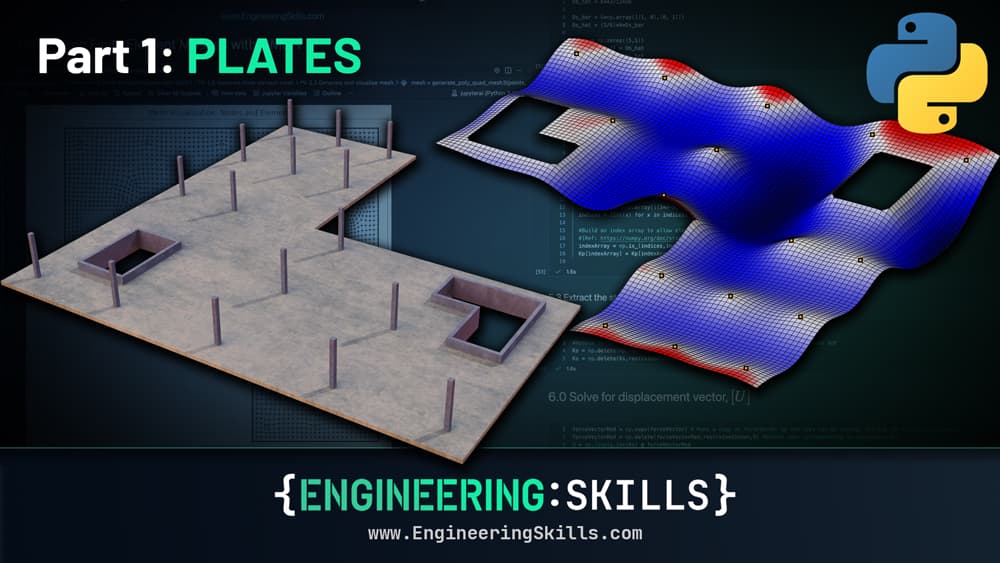
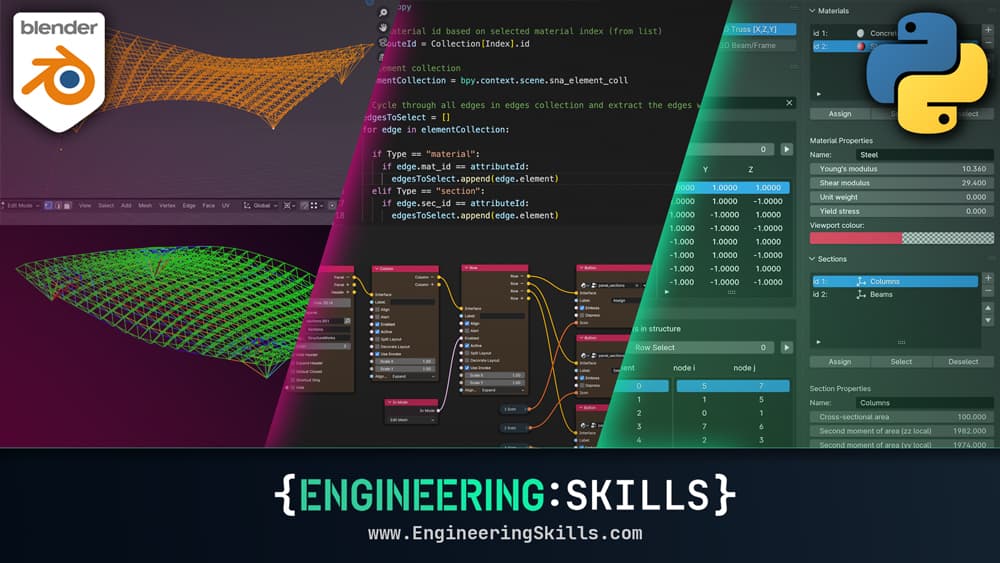
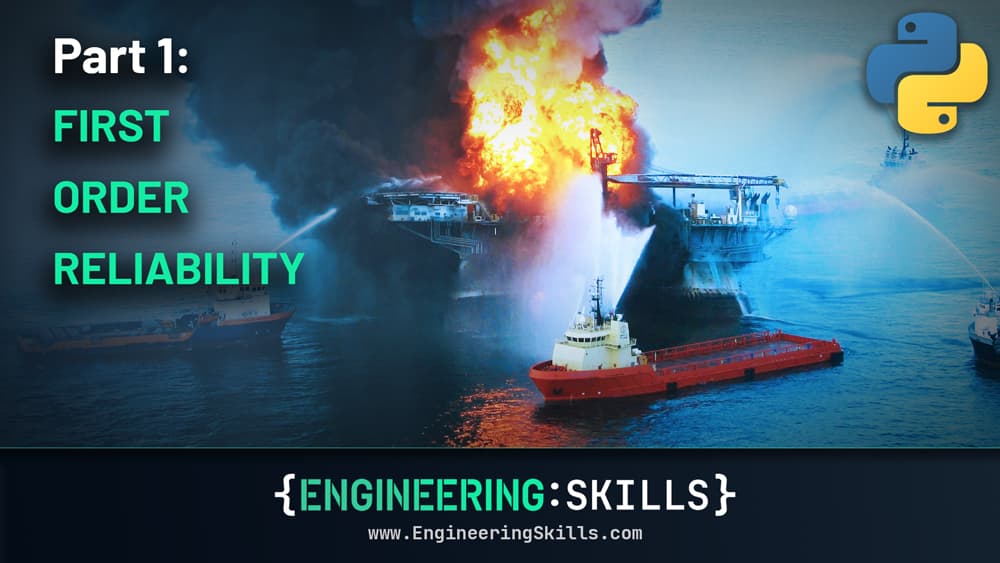
Featured Tutorials and Guides
If you found this tutorial helpful, you might enjoy some of these other tutorials.
Plate Girder Design to Eurocode 3
A step-by-step guide to the design of code-compliant steel plate girders.

Callum Wilson
Bonsai BIM - The Essential IFC Tool for Structural Engineering Workflows
The IFC tool every structural engineer should have in their toolkit

Petru Conduraru

